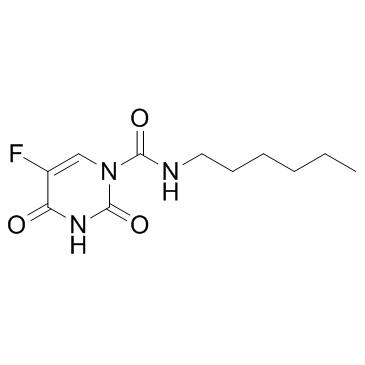Discovery of highly potent acid ceramidase inhibitors with in vitro tumor chemosensitizing activity.
Natalia Realini, Carlos Solorzano, Chiara Pagliuca, Daniela Pizzirani, Andrea Armirotti, Rosaria Luciani, Maria Paola Costi, Tiziano Bandiera, Daniele Piomelli
Index: Sci. Rep. 3 , 1035, (2013)
Full Text: HTML
Abstract
The expression of acid ceramidase (AC) - a cysteine amidase that hydrolyses the proapoptotic lipid ceramide - is abnormally high in several human tumors, which is suggestive of a role in chemoresistance. Available AC inhibitors lack, however, the potency and drug-likeness necessary to test this idea. Here we show that the antineoplastic drug carmofur, which is used in the clinic to treat colorectal cancers, is a potent AC inhibitor and that this property is essential to its anti-proliferative effects. Modifications in the chemical scaffold of carmofur yield new AC inhibitors that act synergistically with standard antitumoral drugs to prevent cancer cell proliferation. These findings identify AC as an unexpected target for carmofur, and suggest that this molecule can be used as starting point for the design of novel chemosensitizing agents.
Related Compounds
| Structure | Name/CAS No. | Molecular Formula | Articles |
|---|---|---|---|
 |
Carmofur
CAS:61422-45-5 |
C11H16FN3O3 |
|
Sphingoid long chain bases prevent lung infection by Pseudom...
2014-09-01 [EMBO Mol. Med. 6(9) , 1205-14, (2014)] |
|
Lysosomal glycosphingolipid catabolism by acid ceramidase: f...
2016-03-01 [FEBS Lett. 590 , 716-25, (2016)] |
|
Efficacy of oral adjuvant therapy after resection of colorec...
2004-02-01 [J. Clin. Oncol. 22(3) , 484-92, (2004)] |
|
Raltitrexed treatment promotes systemic inflammatory reactio...
2002-09-09 [Br. J. Cancer 87(6) , 591-9, (2002)] |
|
Subacute leucoencephalopathy induced by carmofur, a 5-fluoro...
1987-08-01 [J. Neurol. 234(6) , 365-70, (1987)] |